
DEPARTMENT DIRECTORY
Governor Doug Burgum
ADMINISTRATIVE DIVISION
Game and Fish Director: Jeb Williams
Deputy Director: Scott Peterson
Chief, Administrative Services: Kim Kary
Federal Aid Manager: Corey Wentland
Administrative Staff Officer: Justin Mattson
Administrative Assistant: Lynn Timm
Building Maint. Supervisor: Brandon Diehl
Administrative Officer: Melissa Long, Alan Peterson
Accounting Manager: Angie Morrison
Accountants: Kelly Wike, Ashley Hillerson
Business Operations Manager: Brian Hosek
Technical Operations Lead: Alan Reile
Data Scientist: Shane Wegner
Licensing Manager: Randy Meissner
Assistants: Gail Mosset, Amanda Anstrom, Tracy Price, Tana Bentz, Tanya Mikkelsen
Administrative Assistant – Dickinson: Stephanie Richardson
Administrative Assistant – Devils Lake: Lisa Tofte
Administrative Assistant – Jamestown: Tonya Kukowski
Administrative Assistant – Riverdale: Mattea Bierman
Administrative Assistant – Williston: Nikki Wright
CONSERVATION AND COMMUNICATIONS DIVISION
Division Chief: Greg Link, Bismarck
Communications Supervisor: Greg Freeman, Bismarck
Editor: North Dakota OUTDOORS: Ron Wilson, Bismarck

R3 Coordinator: Cayla Bendel, Bismarck
Digital Media Editor: Lara Anderson, Bismarck
Video Project Supervisor: Mike Anderson, Bismarck
Photographer/Videographer: Ashley Peterson, Bismarck
Marketing Specialist: Jackie Ressler, Bismarck
Information Specialist: Dawn Jochim, Bismarck
Graphic Artist: Kristi Fast, Bismarck
Education Supervisor: Marty Egeland, Bismarck
Education Coordinator: Jeff Long, Bismarck
Hunter Education Coordinator: Brian Schaffer, Bismarck
Outreach Biologists: Doug Leier, West Fargo; Greg Gullickson, Minot; Jim Job, Grand Forks
Conservation Supervisor: Steve Dyke, Bismarck
Resource Biologists: John Schumacher, Bruce Kreft, Bismarck
Conservation Biologists: Sandra Johnson, Patrick Isakson, Elisha Mueller, Bismarck
Administrative Assistant: Amber Schroeter, Bismarck
ENFORCEMENT DIVISION
Division Chief: Scott Winkelman, Bismarck
Investigative Supervisor: Jim Burud, Kenmare
Operations Supervisor: Jackie Lundstrom, Bismarck
Warden Pilot: Jeff Sieger, Bismarck
Region No. 1 Warden Supvr: Mark Pollert, Jamestown
District Wardens: Corey Erck, Bismarck; Michael Sedlacek, Fargo; Andrew Dahlgren, Milnor; Erik Schmidt, Linton; Greg Hastings, Jamestown; Paige Swanson, Steele
Region No. 2 Warden Supvr: Paul Freeman, Devils Lake
District Wardens: Jonathan Tofteland, Bottineau; Jonathan Peterson, Devils Lake; James Myhre, New Rockford; Blake Riewer, Grand Forks; Alan Howard, Cando; Peter Miley, Cavalier; Drew Johnson, Finley; Sam Feldmann, Rugby
Region No. 3 Warden Supvr: Doug Olson, Riverdale
District Wardens: Joe Lucas, Turtle Lake; Ken Skuza, Riverdale; Michael Raasakka, Stanley; Connor Folkers, Watford City; Shawn Sperling, Minot; Keenan Snyder, Williston, Josh Hedstrom: Tioga
Region No. 4 Warden Supvr: Dan Hoenke, Dickinson
District Wardens: Kylor Johnston, Hazen; Art Cox, Bowman; Courtney Sprenger, Elgin; Zane Manhart, Golva; Jerad Bluem, Mandan; Zachary Schuchard, Richardton
Administrative Assistant: Lori Kensington, Bismarck
WILDLIFE DIVISION
Division Chief: Casey Anderson, Bismarck
Assistant Division Chief: Bill Haase, Bismarck
Game Mgt. Section Leader: Stephanie Tucker, Bismarck
Pilot: Jeff Faught, Bismarck
Upland Game Mgt. Supvr: Jesse Kolar, Dickinson
Upland Game Mgt. Biologist: Rodney Gross, Bismarck
Migratory Game Bird Mgt. Supvr: Mike Szymanski, Bismarck
Migratory Game Bird Biologist: Andrew Dinges, Bismarck
Big Game Mgt. Supvr: Bruce Stillings, Dickinson
Big Game Mgt. Biologists: Bill Jensen, Bismarck; Brett Wiedmann, Dickinson; Jason Smith, Jamestown
Survey Coordinator: Chad Parent, Bismarck
Wildlife Veterinarian: Dr. Charlie Bahnson, Bismarck
Game Management Biotechnician: Ryan Herigstad, Bismarck
Wildlife Resource Management Section Leader: Kent Luttschwager, Williston
Wildlife Resource Mgt. Supvrs: Brian Prince, Devils Lake; Brian Kietzman, Jamestown; Dan Halstead, Riverdale; Blake Schaan, Lonetree; Levi Jacobson, Bismarck
Wildlife Resource Mgt. Biologists: Randy Littlefield, Lonetree; Rodd Compson, Jamestown; Judd Jasmer, Dickinson; Todd Buckley, Williston; Jake Oster, Riverdale
Wildlife Biological Technicians: Tom Crutchfield, Jim Houston, Bismarck; Dan Morman, Robert Miller, Riverdale; Jason Rowell, Jamestown; Brandon Ramsey, Jace Brodzinski, Lonetree; Scott Olson, Devils Lake; Zach Eustice, Williston
Private Land Section Leader: Kevin Kading, Bismarck
Private Land Field Operation Supvrs: Nathan Harling, West Region; Curtis Francis, East
Region, Bismarck
Private Land Biologists: Colin Penner, Bismarck; Jaden Honeyman, Ryan Oberhelman, Dickinson; Ryan Huber, Riverdale; Renae Schultz, Jamestown; Terry Oswald, Jr., Lonetree; Andrew Ahrens, Devils Lake; Jens Johnson, Bismarck; Erica Sevigny, Williston
Procurement Officer: Dale Repnow, Bismarck
Administrative Assistant: Alegra Powers, Bismarck
Lonetree Administrative Assistant: Diana Raugust, Harvey
FISHERIES DIVISION
Division Chief: Greg Power, Bismarck
Fisheries Mgt. Section Leader: Scott Gangl, Bismarck
Fisheries Supvrs: Jason Lee, Riverdale; Paul Bailey, Bismarck; Randy Hiltner, Devils Lake; Dave Fryda, Riverdale; Brandon Kratz, Jamestown
Fisheries Biologists: Russ Kinzler, Riverdale; Todd Caspers, Devils Lake; Aaron Slominski, Williston; Mike Johnson, Jamestown; Jeff Merchant, Dickinson
Fisheries Biological Technicians: Phil Miller, Devils Lake; Pat John, Jamestown; Justen Barstad, Bismarck; Brian Frohlich, Riverdale
Production/Development Section Supvr: Jerry Weigel, Bismarck
Aquatic Nuisance Species Coordinator: Benjamin Holen, Jamestown
Aquatic Nuisance Species Biologist: Grant Kapaun, Bismarck
Aquatic Habitat Supvr: Scott Elstad, Bismarck
Fisheries Development Supvr: Bob Frohlich, Bismarck
Fisheries Dev. Proj. Mgr: Wesley Erdle, Bismarck
Fisheries Development Specialist: Kyle Hoge, Mason Ryckman, Zach Kjos, Bismarck
Administrative Assistant: Janice Vetter, Bismarck
ADVISORY BOARD
District 1 Beau Wisness, Keene
District 2 Travis Leier, Velva
District 3 Edward Dosch, Devils Lake
District 4 Bruce Ellertson, Michigan
District 5 Doug Madsen, Harwood
District 6 Cody Sand, Ashley
District 7 Jody Sommer, Mandan
District 8 Rob Brooks, Rhame
•
•
24,000 Canada geese were estimated on the Missouri River during the North Dakota Game and Fish Department’s annual midwinter waterfowl survey in early January. The
was low, but expected, considering heavy snowfall and cold temperatures
months
Periodical Postage Paid at Bismarck, ND 58501 and additional entry offices. Printed in the United States POSTMASTER: Send address changes to: North Dakota OUTDOORS 100 North Bismarck Expressway Bismarck, ND 58501-5095 Report All Poachers (RAP) 701-328-9921 In cooperation with North Dakota Wildlife Federation and North Dakota State Radio. Official publication of the North Dakota Game and Fish Department (ISSN 0029-2761) 100 N. Bismarck Expressway, Bismarck, ND 58501-5095 Website: gf.nd.gov • Email: ndgf@nd.gov • Information 701-328-6300 • Licensing 701-328-6335
Administration 701-328-6305
About
count
in the
leading up to the survey.
•
North Dakota Outdoors Subscriptions 701-328-6363
Hunter Education 701-328-6615
•
The TTY/TTD (Relay ND) number for the hearing or speech
is 800-366-6888
impaired
The mission of the North Dakota Game and Fish Department is to protect, conserve and enhance fish and wildlife populations and their habitats for sustained public consumptive and nonconsumptive use.


2 2022 Deer Drawing
8 2022 Enforcement Division Review
12 Uncovering Turkey Unknowns
16 Succeeding by Recognizing Past Shortcomings
20 Buffaloberry Patch
25 Back Cast
North Dakota OUTDOORS is published 10 times a year, monthly except for the months of April and September. Subscription rates are $10 for one year or $20 for three years. Group rates of $7 a year are available to organizations presenting 25 or more subscriptions. Remittance should be by check or money order payable to the North Dakota Game and Fish Department. Indicate if subscription is new or renewal. The numbers on the upper right corner of the mailing label indicate the date of the last issue a subscriber will receive unless the subscription is renewed.

Permission to reprint materials appearing in North Dakota OUTDOORS must be obtained from the author, artist or photographer. We encourage contributions; contact the editor for writer and photography guidelines prior to submission.
The NDGFD receives Federal financial assistance from the US Fish and Wildlife Service and the US Coast Guard. In accordance with Title VI of the Civil Rights Act of 1964, Section 504 of the Rehabilitation Act of 1973, Title II of the Americans with Disabilities Act of 1990, the Age Discrimination Act of 1975, and Title IX of the Education Amendments of 1972, the NDGFD joins the US Department of the Interior and its Bureaus and the US Department of Homeland Security in prohibiting discrimination on the basis of race, color, national origin, age, disability, sex (in education programs or activities) and also religion. If you believe you have been discriminated against in any program, activity, or facility as described above, or you desire further information, please write to: ND Game and Fish Department, Attn: Chief of Administrative Services, 100 N. Bismarck Expressway, Bismarck, ND 58501-5095 or to: Office of Civil Rights, Department of the Interior, 1849 C Street, NW, Washington, DC 20240.
FEBRUARY 2023 • NUMBER 7 • VOLUME LXXXV ■ Editor: Ron Wilson ■ Graphic Designer: Kristi Fast ■ Circulation Manager: Dawn Jochim
Front Cover Jim Houston, Game and Fish Department wildlife biological technician, releases wild turkeys in late January on a Department wildlife management area south of Mandan.
by Ashley Peterson.
CONTENTS
Photo
ASHLEY PETERSON
Game and Fish made available 64,200 licenses for the 2022 deer gun hunting season, a decrease of 8,000 from 2021.
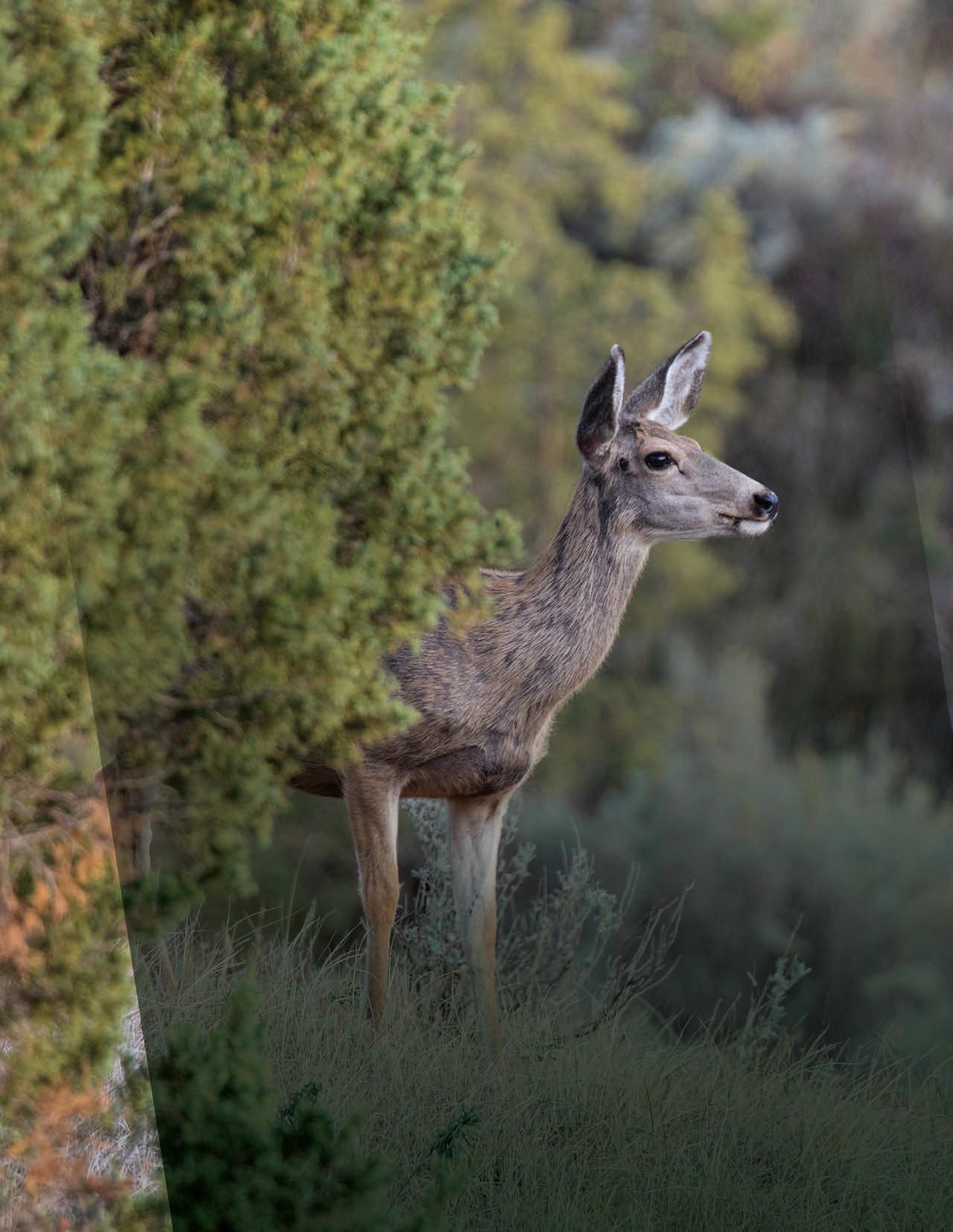
2 ■ ND OUTDOORS ■ FEBRUARY 2023
By Ron Wilson
While 8,000 fewer licenses were made available for the deer gun season in 2022, the process remained the same as all who applied did so electronically.
The format used to present the results of the deer drawing – plus drawings for pronghorn and spring and fall turkey – is consistent with the last three years.
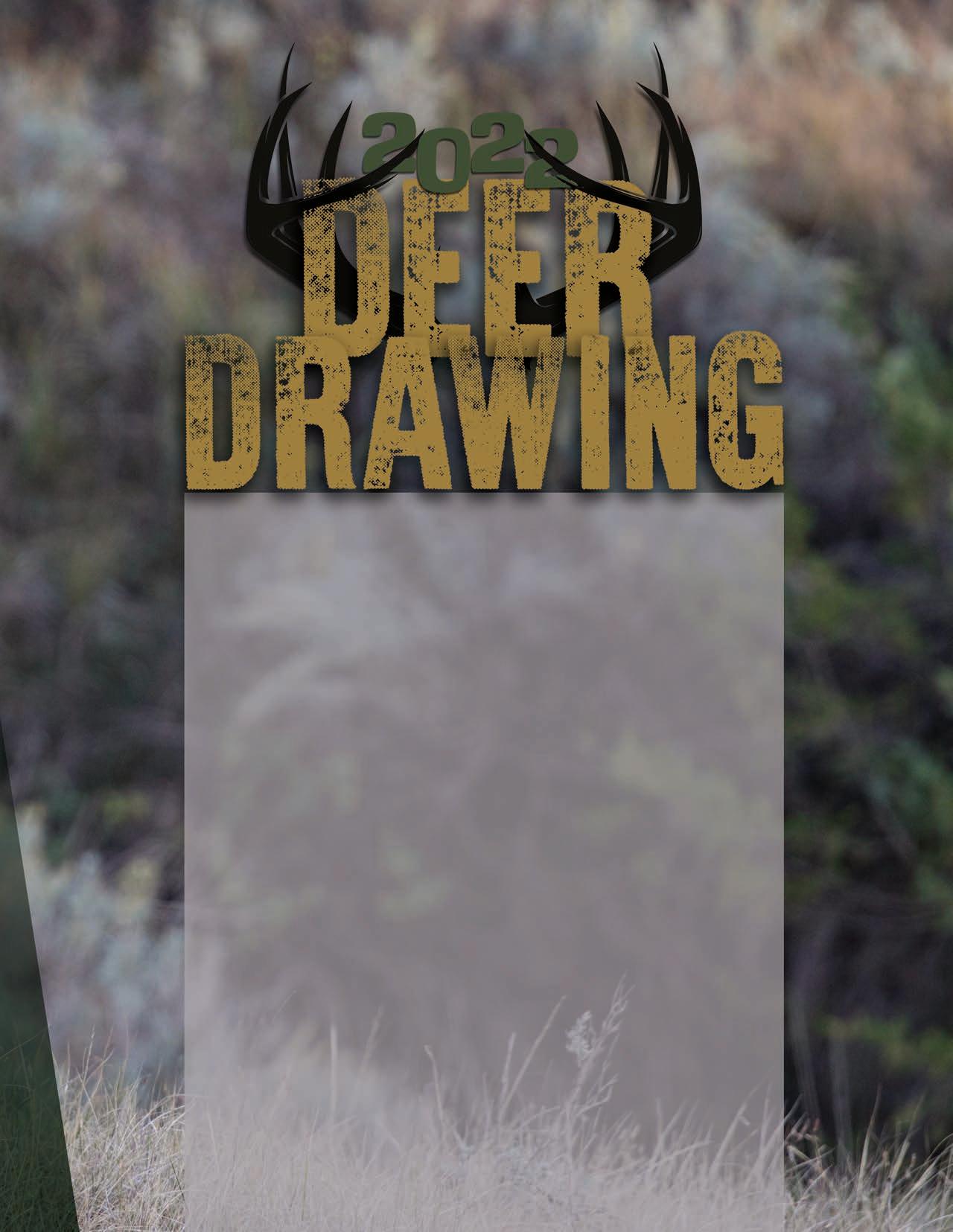
The tables provided show the first-choice results in the first lottery. Using deer hunting unit 2J1 for any antlered deer as an example, the numbers read like this: 748 hunters with zero bonus points applied for an any antlered deer license and 261 were successful in drawing a license (261/748); 496 hunters with one bonus point applied and 336 were successful (336/496); 159 hunters with two bonus points applied and 141 were successful (141/159); and on it goes.
In short, the tables show the results for those hunters with the same number of bonus points applying for a particular license in a particular hunting unit.
It’s important to note that the deer lottery results do not include the 1% of licenses state law requires the Game and Fish Department to make available for nonresident applicants every year.
Those nonresidents who do apply for a deer gun license in North Dakota compete only against other nonresident hunters for that 1%.
Also of note, the results in the 2022 deer gun lottery show only those hunters who were in the drawing, not those hunters who bought bonus points and had no intention of hunting deer last fall.
RON WILSON is editor of North Dakota OUTDOORS.
ND OUTDOORS ■ FEBRUARY 2023 ■ 3
SANDRA JOHNSON

POINTS UNIT UNIT / TYPE 0 1 2 3 4 5 6 7 8 9 10+ TOTAL APPS. 4 ■ ND OUTDOORS ■ FEBRUARY 2023
2022 DEER LICENSE LOTTERY RESULTS
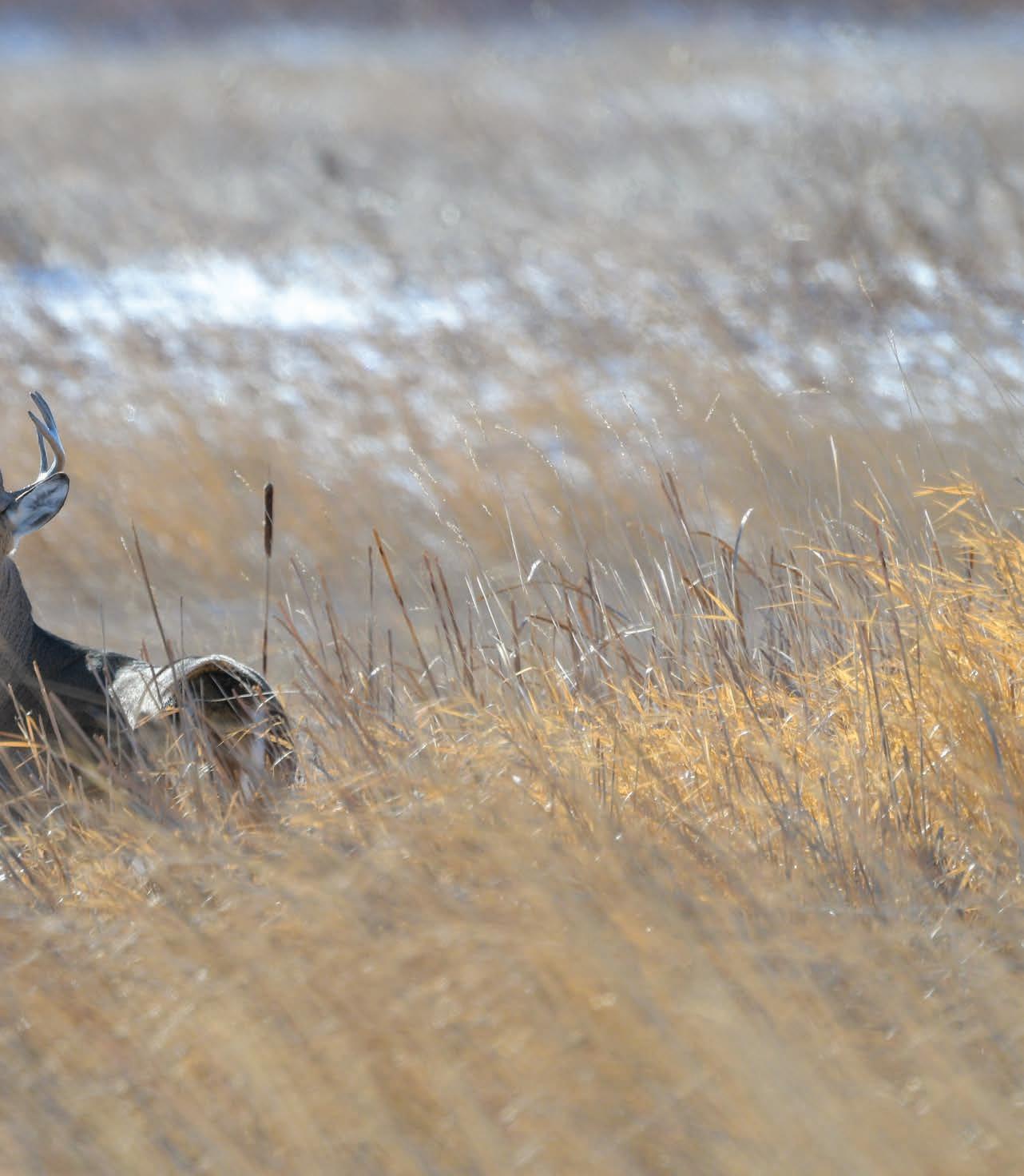
POINTS UNIT UNIT / TYPE 0 1 2 3 4 5 6 7 8 9 10+ TOTAL APPS. ND OUTDOORS ■ FEBRUARY 2023 ■ 5
2022 DEER LICENSE LOTTERY RESULTS
HOW THE LOTTERY WORKS
There are always questions concerning the Game and Fish Department’s lottery.
Using deer as the example, though turkey works the same way, this is how it works.
If you fail to draw your first license choice in any given year, you receive a bonus point. You do not have to apply in the same unit, or for the same deer type each year, to qualify. You get an additional bonus point each year you apply and do not receive your first license choice. You maintain your accumulated bonus points as long as you apply in the first drawing at least once every two years.
You receive additional chances in the drawing for each bonus point accumulated. For points one through three, you are entered in the drawing two times the number of points you have. So, if you have two points you would get four additional chances to be drawn, compared to a person who got his or her first choice the previous year. If you’re both competing for the same license, you have five chances, he or she has one.
When you accumulate four or more points, the number of additional chances is determined by cubing your bonus points. So, when you have four points, you will be in the drawing 64 additional times, 125 times if you have five points, and so on. Bonus points are accumulated if you do not draw your first license choice and apply in the first drawing at least every other year. You do not receive bonus points in years you do not apply.
Each drawing is still random, but the more bonus points you have, the better your odds. When you receive your first license choice, you lose your bonus points and start over. Bonus points can only be earned, or used, in the first drawing for each species in each year.
The license lottery consists of four separate drawings, one for each choice on the application. First, we hold a drawing for the first unit/ first deer choice. When those are issued, we draw for the first unit/second deer choice, then the second unit/first deer choice, and finally the second unit/second deer choice.
2022 SPRING TURKEY LOTTERY RESULTS
2022 FALL TURKEY LOTTERY RESULTS
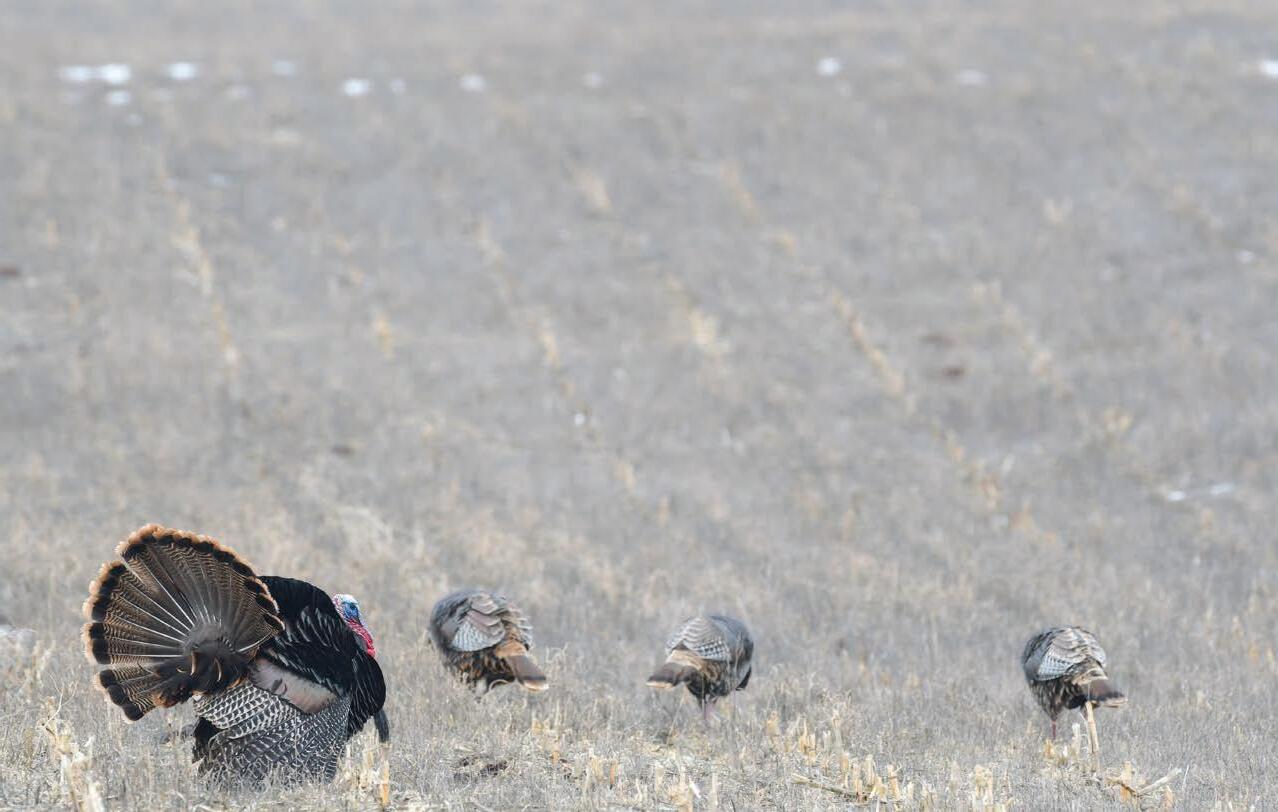
POINTS UNIT 0 1 2 3 4 5 6 7 8 9 10+ TOTAL APPS. 02 134 / 333 94 / 133 27 / 29 0 / 0 0 / 0 0 / 0 0 / 0 0 / 0 0 / 0 0 / 0 0 / 0 495 03 68 / 68 1 / 1 0 / 0 0 / 0 0 / 0 0 / 0 0 / 0 0 / 0 0 / 0 0 / 0 0 / 0 69 04 107 / 164 38 / 39 1 / 1 0 / 0 0 / 0 0 / 0 0 / 0 0 / 0 0 / 0 0 / 0 0 / 0 204 06 21 / 21 1 / 1 0 / 0 0 / 0 0 / 0 0 / 0 0 / 0 0 / 0 0 / 0 0 / 0 0 / 0 22 13 364 / 364 16 / 16 0 / 0 0 / 0 0 / 0 0 / 0 0 / 0 0 / 0 0 / 0 0 / 0 0 / 0 380 17 280 / 333 106 / 107 8 / 8 0 / 0 0 / 0 0 / 0 0 / 0 0 / 0 0 / 0 0 / 0 0 / 0 448 19 238 / 238 2 / 2 0 / 0 0 / 0 0 / 0 0 / 0 0 / 0 0 / 0 0 / 0 0 / 0 0 / 0 240 25 758 / 758 20 / 20 1 / 1 0 / 0 0 / 0 0 / 0 0 / 0 0 / 0 0 / 0 0 / 0 0 / 0 779 27 577 / 752 183 / 188 17 / 17 0 / 0 0 / 0 0 / 0 0 / 0 0 / 0 0 / 0 0 / 0 0 / 0 957 30 711 / 711 30 / 30 1 / 1 1 / 1 0 / 0 0 / 0 0 / 0 0 / 0 0 / 0 0 / 0 0 / 0 743 31 23 / 23 0 / 0 0 / 0 0 / 0 0 / 0 0 / 0 0 / 0 0 / 0 0 / 0 0 / 0 0 / 0 23 37 445 / 714 226 / 236 33 / 33 0 / 0 0 / 0 0 / 0 0 / 0 0 / 0 0 / 0 0 / 0 0 / 0 983 40 21 / 65 17 / 22 2 / 3 0 / 0 0 / 0 0 / 0 0 / 0 0 / 0 0 / 0 0 / 0 0 / 0 90 44 98 / 98 5 / 5 0 / 0 0 / 0 0 / 0 0 / 0 0 / 0 0 / 0 0 / 0 0 / 0 0 / 0 103 45 61 / 61 6 / 6 0 / 0 0 / 0 0 / 0 0 / 0 0 / 0 0 / 0 0 / 0 0 / 0 0 / 0 67 47 33 / 47 1 / 1 0 / 0 1 / 1 0 / 0 0 / 0 0 / 0 0 / 0 0 / 0 0 / 0 0 / 0 49 50 231 / 466 181 / 210 26 / 27 0 / 0 0 / 0 0 / 0 0 / 0 0 / 0 0 / 0 0 / 0 0 / 0 703 51 361 / 361 7 / 7 1 / 1 0 / 0 0 / 0 0 / 0 0 / 0 0 / 0 0 / 0 0 / 0 0 / 0 369 53 119 / 119 38 / 38 9 / 9 0 / 0 0 / 0 0 / 0 0 / 0 0 / 0 0 / 0 0 / 0 0 / 0 166 98 326 / 570 130 / 148 12 / 12 0 / 0 0 / 0 0 / 0 0 / 0 0 / 0 0 / 0 0 / 0 0 / 0 730 99 220 / 268 10 / 10 0 / 0 0 / 0 0 / 0 0 / 0 0 / 0 0 / 0 0 / 0 0 / 0 0 / 0 278
POINTS UNIT 0 1 2 3 4 5 6 7 8 9 10+ TOTAL APPS. 02 7 / 154 10 / 66 8 / 24 2 / 11 3 / 3 0 / 0 0 / 0 0 / 0 0 / 0 0 / 0 0 / 0 258 03 23 / 26 10 / 10 0 / 0 0 / 0 0 / 0 0 / 0 0 / 0 0 / 0 0 / 0 0 / 0 0 / 0 36 04 132 / 132 3 / 3 1 / 1 0 / 0 0 / 0 0 / 0 0 / 0 0 / 0 0 / 0 0 / 0 0 / 0 136 06 17 / 18 0 / 0 0 / 0 0 / 0 0 / 0 0 / 0 0 / 0 0 / 0 0 / 0 0 / 0 0 / 0 18 13 230 / 230 3 / 3 0 / 0 0 / 0 0 / 0 0 / 0 0 / 0 0 / 0 0 / 0 0 / 0 0 / 0 233 17 79 / 182 47 / 60 9 / 10 0 / 0 0 / 0 0 / 0 0 / 0 0 / 0 0 / 0 0 / 0 0 / 0 252 19 152 / 152 3 / 3 1 / 1 0 / 0 0 / 0 0 / 0 0 / 0 0 / 0 0 / 0 0 / 0 0 / 0 156 25 284 / 284 1 / 1 0 / 0 0 / 0 0 / 0 0 / 0 0 / 0 0 / 0 0 / 0 0 / 0 0 / 0 285 27 215 / 300 113 / 118 13 / 13 0 / 0 0 / 0 0 / 0 0 / 0 0 / 0 0 / 0 0 / 0 0 / 0 431 30 280 / 280 11 / 11 0 / 0 0 / 0 0 / 0 0 / 0 0 / 0 0 / 0 0 / 0 0 / 0 0 / 0 291 31 25 / 25 1 / 1 0 / 0 0 / 0 0 / 0 0 / 0 0 / 0 0 / 0 0 / 0 0 / 0 0 / 0 26 37 174 / 286 88 / 92 7 / 7 2 / 2 0 / 0 0 / 0 0 / 0 0 / 0 0 / 0 0 / 0 0 / 0 387 40 13 / 35 3 / 9 0 / 0 0 / 0 0 / 0 0 / 0 0 / 0 0 / 0 0 / 0 0 / 0 0 / 0 44 44 55 / 55 1 / 1 1 / 1 0 / 0 0 / 0 0 / 0 0 / 0 0 / 0 0 / 0 0 / 0 0 / 0 57 45 59 / 59 5 / 5 0 / 0 0 / 0 0 / 0 0 / 0 0 / 0 0 / 0 0 / 0 0 / 0 0 / 0 64 47 19 / 21 4 / 4 0 / 0 0 / 0 0 / 0 0 / 0 0 / 0 0 / 0 0 / 0 0 / 0 0 / 0 25 50 103 / 241 69 / 88 16 / 17 0 / 0 0 / 0 0 / 0 0 / 0 0 / 0 0 / 0 0 / 0 0 / 0 346 51 159 / 159 1 / 1 0 / 0 0 / 0 0 / 0 0 / 0 0 / 0 0 / 0 0 / 0 0 / 0 0 / 0 160 53 24 / 61 23 / 28 1 / 1 0 / 0 0 / 0 0 / 0 0 / 0 0 / 0 0 / 0 0 / 0 0 / 0 90 98 115 / 256 52 / 74 9 / 9 0 / 0 0 / 0 0 / 0 0 / 0 0 / 0 0 / 0 0 / 0 0 / 0 339 99 32 / 71 17 / 25 6 / 7 0 / 0 0 / 0 0 / 0 0 / 0 0 / 0 0 / 0 0 / 0 0 / 0 103
SANDRA JOHNSON 6 ■ ND OUTDOORS ■ FEBRUARY 2023
2022 LOTTERY NOTES
The number of deer gun licenses made available to hunters:
• 2016 – 49,000 deer gun licenses.
• 2017 – 54,500 deer gun licenses.
• 2018 – 55,150 deer gun licenses.
• 2019 – 65,500 deer gun licenses.
• 2020 – 69,050 deer gun licenses.
• 2021 – 72,200 deer gun licenses.
• 2022 – 64,200 deer gun license.
Drawing a buck license in 2022 was, like most years, not easy. Randy Meissner, Game and Fish Department licensing manager, said after 11,987 resident gratis licenses and 642 nonresident licenses were subtracted from the overall license allocation, just 26,110 buck licenses were available for the 63,704 hunters who applied for them as their first choice in the lottery.
2022 LOTTERY STATS
DEER
• 76,783 – Number of people – not including 12,291 gratis applicants – who applied for deer gun lottery licenses, down from 79,857 in 2021.
• 52.69 – Percent of successful applicants, excluding gratis and nonresidents, for deer gun and muzzleloader licenses.
• 20 – Maximum number of bonus points for any applicant (nonresident mule deer buck applicants).
• 12,746 – Applicants with four or more bonus points.
• 13.73 – Percent of applicants with four or more bonus points.
• 52.51 – Percent of applicants with four or more bonus points who applied for a muzzleloader buck license.
TURKEY
• 84.2 – Percent of successful applicants for the spring season.
• 81.7 – Percent of applicants who received their first license choice for the spring season.
• 3,975 – Number of fall turkey licenses available, up from 3,825 in 2021.
• 77.3 – Percent of successful applicants for the fall season.
• 73.3 – Percent of applicants who received their first license choice for the fall season.
PRONGHORN
• 17 – Number of hunting units openfor the pronghorn season.
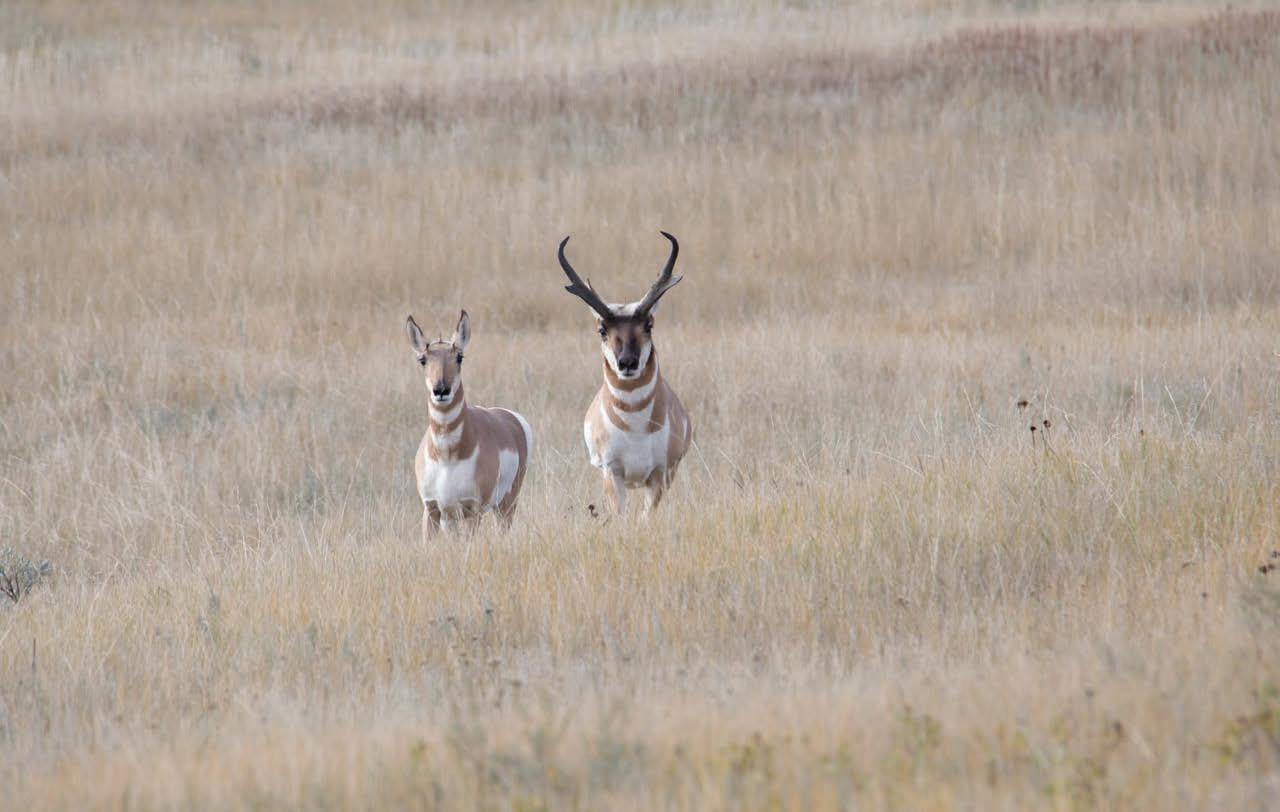
• 1,970 – Number of licenses available to hunters, up 250 from 2021.
• 15,681 – Number of people who applied for available licenses, up 276 from 2021.
Whitetail doe.
• 7,647 – Number of spring turkey licenses available to hunters, up from 7,012 in 2021.
POINTS UNIT UNIT / TYPE 0 1 2 3 4 5 6 7 8 9 10+ TOTAL APPS.
2022 PRONGHORN LOTTERY RESULTS
JESSE KOLAR
ND OUTDOORS ■ FEBRUARY 2023 ■ 7
2022 Enforcement Division Review

 By Scott Winkelman
By Scott Winkelman
The North Dakota Game and Fish Department’s enforcement division had another tremendous year in 2022. The effort and professionalism exhibited by game wardens of this fine state are second to none, and I am extremely proud of the work they all do in protecting our wildlife, habitat, and those who enjoy it. They truly are the “best of the best” in law enforcement.
The amount of work and responsibility game wardens of North Dakota are responsible for is really eye opening. North Dakota has the third smallest number of wildlife law enforcement officers in the nation, with 38 full time game wardens, with each patrolling districts covering an estimated 2,438 square miles. Only Delaware (30) and Rhode Island (32) have fewer game wardens. When you consider that those states are about the same size as Cass and Grand Forks counties, it really is a testament to the amount of great work our game wardens do.

In the following pages you will see the citation and field contact information for the past year. It is important to note that by state law all fines and fees collected due to convictions for these citations are paid to the county where the violation occurred and added to the state school fund. The North Dakota Game and Fish Department does not receive any funding from the fines or fees associated with citations issued.
I hope that you all find time in 2023 to safely enjoy the wildlife and waters that our game wardens have dedicated their careers and time protecting.
 SCOTT WINKELMAN is the Game and Fish Department’s chief warden.
ASHLEY PETERSON
SCOTT WINKELMAN is the Game and Fish Department’s chief warden.
ASHLEY PETERSON
8 ■ ND OUTDOORS ■ FEBRUARY 2023
Mike Sedlacek, Game and Fish warden, checks a hunter’s take during a Department check station in southeastern North Dakota in October.
Peterson Named Wildlife Officer of the Year



Jonathan Peterson, North Dakota Game and Fish Department district game warden in Devils Lake, is the state’s 2022 Wildlife Officer of the Year. Johnson was honored by Shikar-Safari Club International, a private conservation organization that annually recognizes outstanding wildlife officers in each state.
In a nomination letter sent to Shikar-Safari, chief warden Scott Winkelman said Peterson’s district contains North Dakota’s largest natural lake, Devils Lake.
“The Devils Lake region is known for its year-round fishing and fall waterfowl hunting. Warden Peterson patrols by vehicle, boat, ATV/UTV and snowmobile to accomplish his enforcement goals in all four seasons,” Winkelman said. “He works diligently to be in the right place at the right time to promote safety and deter violators. He has been a very effective and efficient game warden by building relationships with landowners, who in turn don’t hesitate to call him when violations are occurring. Warden Peterson is an asset to not only the Department but to North Dakota in the protection of our natural resources.”

FIELD CONTACTS


“That’s an important statistic for us to keep. When you think about it, that’s a lot of people we are reaching. A field contact is any time one of our wardens has an interaction with somebody in the field, usually just checking a license, equipment, bag limits. We can answer questions and hopefully point them in the right direction. It’s a friendly interaction and it’s good all around,” said Scott Winkelman, Game and Fish chief warden, of the nearly 47,000 field contacts wardens made in 2022.
Johnston Earns Boating Officer Award
Kylor Johnston, North Dakota Game and Fish Department district game warden, Hazen, was named North Dakota’s Boating Officer of the Year in 2022. His district includes the state’s largest reservoir, Lake Sakakawea. Chief game warden Scott Winkelman said warden Johnston is an asset to the Department and the boating public he serves and is an outstanding example of professionalism to those he works with.
Turkey Federation Honors Folkers
Conner Folkers, North Dakota Game and Fish Department district game warden, Watford City, was named the National Wild Turkey Federation’s Wildlife Officer of the Year for 2022. Doug Olson, Department warden supervisor, said in just two years, Folkers has demonstrated his desire, knowledge and ability to effectively enforce and protect our natural resources in western North Dakota. His investigative skills, Olson added, have proven themselves in bringing violators to justice.
MIKE ANDERSON
ASHLEY PETERSON ASHLEY PETERSON
ASHLEY PETERSON
Scott Winkelman, chief warden (left) and Jonathan Peterson.
Scott Winkelman, chief warden (left) and Kylor Johnston.
Scott Winkelman, chief warden (left) and Conner Folkers.
ND OUTDOORS ■ FEBRUARY 2023 ■ 9
2022 Summary of Violations



Courtney Sprenger, Department game warden in Elgin, checks a hunter’s license. In 2022, game wardens made thousands of field contacts such as this one around the state.

BIG GAME Illegal taking/possession of big game 42 Failure to wear fluorescent orange 14 Tagging violations 27 CWD violations 17 Killing wrong species or sex 7 Shining big game 7 Other big game violations 26 Total 139 SMALL GAME Using gun able to hold more than 3 shells 56 Hunting before/after legal hours 30 Illegal possession/taking 2 Exceeding limit 56 Failure to leave identification or sex of game 53 Killing wrong sex or species 10 Wanton waste 33 Other small game violations 52 Total 292 BOATING Use of unlicensed or unnumbered boat 40 Failure to display boat registration 60 Operating without lights at night 45 Inadequate number of PFDs 268 Water skiing violations 13 Reckless or negligent operation 11 Operating vessel under influence/intoxicated 17 Other boating violations 219 Total 673 FISHING Exceeding limit 86 Fishing in closed/restricted area 3 Fishing with illegal bait 10 Paddlefish violations 8 ANS violations 86 Other fishing violations 130 Total 323 FURBEARER Other Furbearer violations 3 Total 3 GENERAL Use of motor vehicle off established trail 61 Hunting on posted land without permission 38 Aid in concealment of unlawful game 5 Loaded firearm in motor vehicle 37 440-yard violation 6 Littering 17 Hunting in unharvested field 4 Other general violations 9 Total 177 LICENSING Hunting/fishing/trapping without proper license 222 Failure to carry license on person 218 Misrepresentation on license or application 30 Other licensing violations 9 Total 493 WILDLIFE MANAGEMENT AREAS/REFUGE Failure to obey posted regulations 52 Tree stand violations 14 Possession of glass beverage containers 7 Camping violations 2 Prohibited use of motor vehicles 6 PLOTS access violations 19 Other WMA/refuge violations 9 Total 109
• Ramsey – 235 • McLean – 165 • Williams – 181 • McKenzie - 146 • Burleigh - 124 MISCELLANEOUS Possession of controlled substance 30 Possession of drug paraphernalia 24 Open container 12 Minor in possession 30 Criminal trespass 79 Other miscellaneous 15 Total 182 COMMERCIAL Commercial violations 6 Total 6 Grand Total 2,404 INCIDENTS 2022 – TOP 10 COUNTIES (An incident is defined as any situation that requires a response from a game warden. It does not have to be a crime. The situation could be, for example, a stranded angler.) • Cass - 112 • Mountrail - 110 • Stark - 100 • Ward - 90 • Stutsman - 87 Total - 2,730 ASHLEY PETERSON CITATIONS 2022 – TOP 10 COUNTIES • Ramsey - 324 • Williams - 123 • McKenzie - 115 • Benson - 111 • Mclean - 110 • Bottineau - 93 • Burleigh - 92 • Stark - 84 • Kidder - 77 • Mountrail - 77 Total - 2,389
10 ■ ND OUTDOORS ■ FEBRUARY 2023
For an inside look into the life of a game warden, check out Behind the Badge.

gf.nd.gov

ND OUTDOORS ■ FEBRUARY 2023 ■ 11
UNCOVERING TUNKNOWNSURKEY
 By Ron Wilson
By Ron Wilson
Nonnative wild turkeys have populated North Dakota’s landscape for more than 70 years after the first significant and successful introduction in the early 1950s.
While decades later these naked-headed birds occupy most available cover in the state from the badlands to North Dakota’s eastern terminus, there remains plenty of unknowns surrounding this respected game bird pursued by hunters for more than a half-century.

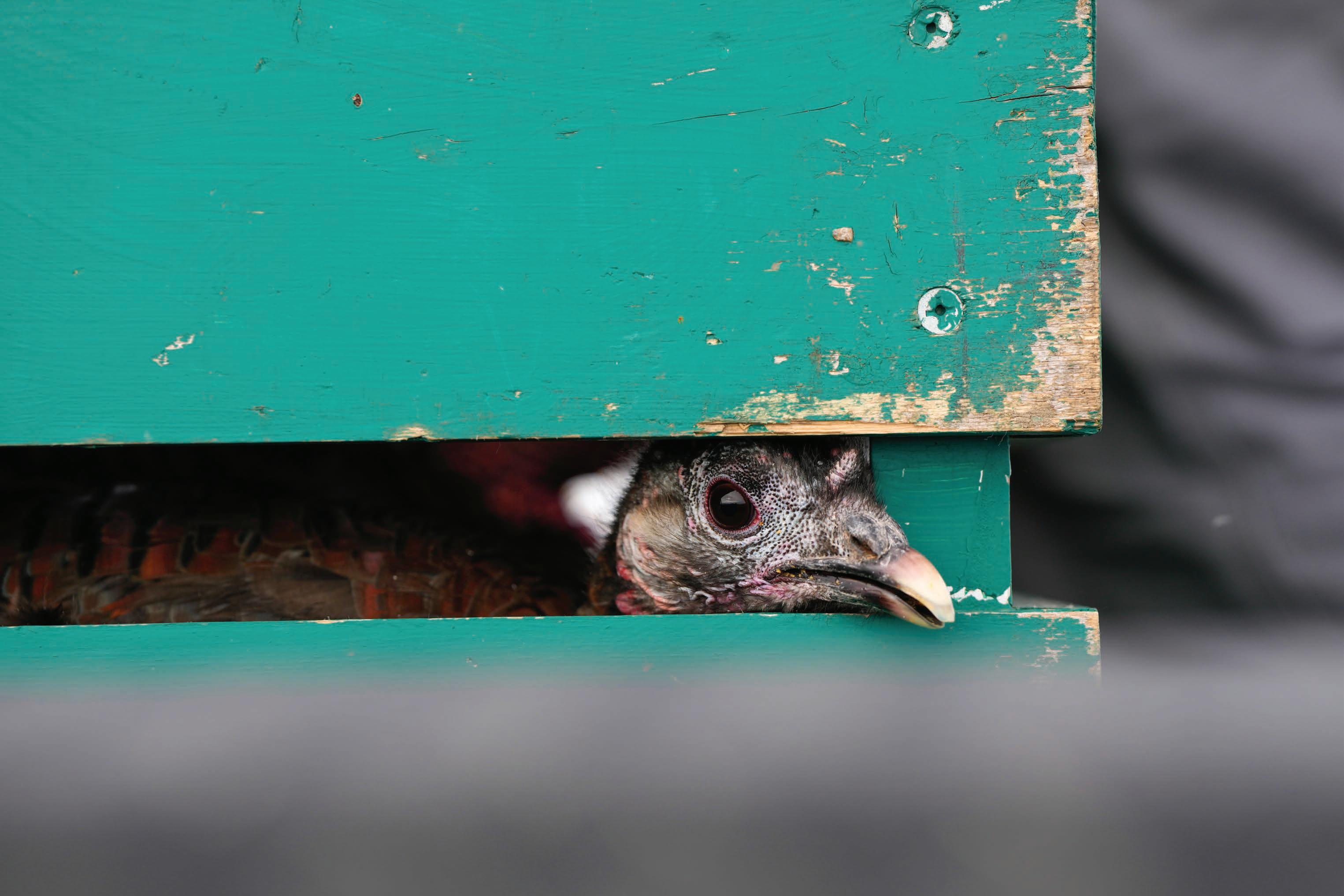
Rodney Gross, North Dakota Game and Fish Department upland game management biologist, said little research has focused on turkeys in the state, leaving biologists to take their best guesses on things such as home ranges, peak nesting season, seasonal movements and peak breeding period.
“If you don’t know things about the species you’re trying to manage, you’re kind of flying in the wind,” Gross said.
A five-year study, in conjunction with the University of North Dakota that kicked off earlier this winter, could answer these questions and others.
Photos by Ashley Peterson
12 ■ ND OUTDOORS ■ FEBRUARY 2023
“If you don’t know things about the species you’re trying to manage, you’re kind of flying in the wind,” Rodney Gross.
“This study could really open our eyes to a lot of different things that we didn’t know about turkeys in North Dakota,” Gross said.
Like a lot of research projects, the title of the study (Evaluating Survival and Movements of Translocated Wild Turkeys in North Dakota) is a mouthful, yet provides some insight into what researchers and biologists hope to learn.
This winter and next, Game and Fish Department personnel will employ rocket/drop nets to capture birds that have descended uninvited on private landowner feed supplies. The goal is to fit a total of 180 turkeys over the course of two winters with backpack-style GPS transmitters with VHF, which will allow researchers to track the birds.
While all of the marked turkeys will be tracked, Gross said some will be moved from the capture site and released at Department wildlife management areas and some, the control birds, will remain.

“The control birds remain because we want to see how they respond to having a big net shot over them and
A wild turkey is fitted with a backpack-style GPS transmitter with VHF, which will allow researchers to track marked birds for the study.

ND OUTDOORS ■ FEBRUARY 2023 ■ 13
getting poked and prodded, as each turkey will have blood drawn,” Gross said. “Also, we want to see how far these turkeys are traveling to gather at these private feed sites. Are they resident birds within a mile or are they coming from 10-15 miles away?”
Capturing and relocating depredating turkeys is not something new to the Department. Game and Fish has been conducting a trap and transport program since 1996, and has relocated, on average, 200 turkeys from five sites a year.

Considering winter started in about mid-November with little indication of when it will end, the number of turkey depredation calls coming in this winter have outnumbered those from last year.

“Compared to last winter when there was little snow and we had maybe two to three depredation events, this winter we’ve already had 10 or 15,” Gross said. “And I see it’s supposed to get cold again … and I’m sure we’re not done with snowstorms. If we get much more snow, animals out there are really going to be in trouble and they’re going to be looking for that easy food.”
Once turkeys are trapped, fitted with GPS backpacks, leg bands and released, monitoring of their movements and whereabouts begins immediately. The bulk of this duty will fall on UND Ph.D. student, Cailey Isaacson, with help from Department personnel.
“She’ll be out right away this winter and check in on the birds from the road or the air from a Game and Fish plane,” Gross said. “But when it gets to springtime in that nesting/ breeding season, then it’ll be more intense as far as the returns we can set on the collars. When it gets to be that breeding season, we might do, 10, 15, 20 reports per day.
Some of the specific questions biologists hope
to answer from the study include:
• Do home ranges differ between translocated birds compared to those simply trapped and released at the depredation site?


• How far do translocated birds move from the release site? Do they stay on the WMA where they were released, or do they return to the original areas?
• How do survival rates compare between translocated turkeys and the control birds?
• Do hens nest after being transported?
“The technology we now have is crazy and will allow us to do a number of things,” he added. “For example, we’re working closely with the University of Georgia. They’ve done countless turkey research projects and they actually have programs where you can input your data and it will pinpoint the turkey nest site without having to physically go in and proof that nest, which is a good thing because
14 ■ ND OUTDOORS ■ FEBRUARY 2023
turkeys are known for abandoning a nest if disturbed and we don’t want to take that chance. With the GPS technology we’ll see the cluster data of where that hen is going day after day, minute after minute, if we want to, which is pretty cool.”
There is also a human component to the study as researchers will visit with landowners to gauge their satisfaction with the translocation efforts and investigate whether hunters are benefiting from turkeys being released on Department owned and managed lands.

“We’re going to sit down with landowners, ask them about the depredation program and if it’s working for them, if they’re happy with it and what are their opinions on turkeys, things like that,” Gross said. “I deal with a lot of the depredations and most of the time the people like the turkeys, but they just don’t like 300 turkeys in their bale stacks.”
Odds are, some hunters this spring will harvest a tom wearing a GPS backpack and a leg band that provides con tact information for the Game and Fish Depart ment. When that hap pens, Gross encourages those hunters to report their kills.

“That’s the data we’re looking for. Just because the turkey didn’t survive, that’s still data,” Gross said. “I would be happy if people would harvest them. That means we’re
providing more opportunities for hunters.”
At the end of the five-year study, researchers are hopeful the findings will result in recommendations that benefit the Game and Fish Department and its wild turkey management strategies. Plus, insight into landowner and hunter perceived benefits, concerns and questions regarding the trap and transport program.
“The more you know gives you more confidence in your management,” Gross said. “Our goal is to manage wildlife based on science, so we’re always trying to use the best available science, no matter the species.”
 RON WILSON is editor of North Dakota OUTDOORS.
RON WILSON is editor of North Dakota OUTDOORS.
ND OUTDOORS ■ FEBRUARY 2023 ■ 15
Cailey Isaacson, UND researcher, and Rodney Gross, Department upland game management biologist, with a turkey trapped north of Mandan.
Succeeding by Recognizing Past Shortcomings

 By Greg Power
By Greg Power
16 ■ ND OUTDOORS ■ FEBRUARY 2023
MIKE ANDERSON
During one’s career, we generally focus on the now and tomorrow. At times, however, its human nature to occasionally hit the pause button, take a look back and highlight successes.
Last year in the March-April issue of North Dakota OUTDOORS, for example, I focused on past, constructive fisheries management decisions/projects in an article titled “A Positive
Walleye in North Dakota
North Dakota OUTDOORS , 1951: “Only in isolated instances have any returns been realized from the plantings. The simple fact is that very few lakes within the state offer conditions under which the walleye can grow and reproduce in sufficient numbers to make angling for him worthwhile … we can, however, state this with reasonable certainty (that) the walleyed pike will not be the dominant species in any of the impoundments thus far created. The necessary requirements for their well-being are just not there.”
Reality Check
Fast forward to 2023. There have never been more walleye in more lakes (223); never more walleye harvested statewide; and never more angler interest as walleye is the number one species for about 80% of North Dakota residents.

Stocking Walleye in the Big Lake
Popular belief in the 1970s and 1980s was that Lake Sakakawea could not be stocked with enough walleye fingerlings to produce a fishery due to its large size (365,000-plus acres).
Reality Check
A multiple-year walleye fingerling stocking study was conducted in lower Lake Sakakawea in the late 1980s and the positive results of the study spring-boarded the strategical stocking of Sakakawea in subsequent years. Periodic stocking has enhanced Lake Sakakawea’s tremendous walleye fishery.
Retrospective.”
On the flip side, we infrequently look in the rearview mirror and identify what didn’t work. To live and learn, no matter your profession, it’s important to recognize some of the past efforts and actions that included some potholes along the way.

Over the course of 70-plus years, the following are a few that did not hold up to the test of time.
Walleye Length Restrictions
To protect walleye populations in the Missouri River System, and in many lakes throughout the state, length restrictions were believed to be needed, particularly between 1991 and 2008.
Reality Check
As recent as 2001, there were 13 waters in North Dakota that had size restrictions, including a 14-inch minimum restriction on Lake Sakakawea from 1991-97, and a maximum of one-over 18 inches limit on Lake Oahe in 2000-01. Respective population assessments, including various biological analyses, determined length restrictions did not serve their intended purpose and led to public confusion. Currently, there are only four waters in the state with size restrictions in place.
MIKE ANDERSON
ND OUTDOORS ■ FEBRUARY 2023 ■ 17
Jackie Ressler of Bismarck with a nice walleye.
Repeated Rainbow Trout Stocking
Many new reservoirs were built in the 1950s and the Game and Fish Department’s fish species of choice to stock into these new waters was rainbow trout. Trout stocking continued into the 1960s and 1970s, but by the 1980s the rate of return (survival) in these waters began to diminish substantially.
This decrease in survival was the result of reservoir aging (a process called eutrophication) causing high trout mortality, especially during winter, and competition with other fish species in the respective reservoirs.
Despite that the “writing was on the wall,” the Department not only continued stocking trout into these waters where there was little return, but occasionally also took an additional step of eradicating lakes of all fish species and then restocking them with trout only.


Reality Check
By around 2000, there was an acceptance that many of our historical trout stockings were not working. Instead of forcing them into waters where the trout no longer thrived, biologists focused on other species that could survive both the heat of summer and prolonged winters. Further, trout production from the hatcheries were reprogrammed to waters where the trout could still survive for extended periods of time or to a growing number of community fisheries where they provide an immediate product for all to catch and enjoy.
Smallmouth Bass in North Dakota
North Dakota OUTDOORS , 1960: “They (smallmouth bass) are not adapted to the type of environment available. Future management will consider only the largemouth bass for stocking small and large impoundments.”
Reality Check
After initially being introduced into various waters, smallmouth bass populations throughout the state are doing remarkably well in terms of both size and numbers. Virtually all smallmouth bass populations in North Dakota today are self-sustaining.


New Prairie Lakes, Short-term Opportunities Only
Beginning in 1993, and continuing to date, generally wet conditions are the norm for North Dakota. As a result, former shallow wetland basins have deepened significantly and have become productive fishing lakes. From the late 1990s through about 2010, the Department mindset was that these new waters were nothing but “flash in the pan” lakes that would not be around long, so the agency should minimize its investment in developing access or good facilities. There was even a belief that many of these new lakes were too shallow (10- to 18-feet deep) and walleye would never survive.
REALITY CHECK
Not only have we experienced a record number of exceptionally productive new(er) prairie lakes that resulted in decades of dependable northern pike and yellow perch fishing opportunities, but as of today there are approximately 75 new walleye fisheries encompassing about 85,000 acres that didn’t exist 20 years ago. The Department now aggressively stocks these waters and, in many cases, has developed new access and boat ramp infrastructure. Even with a worst-case scenario forecasting severe drought for multiple years, many of these prairie lakes will continue to produce for at least another decade. These prairie lakes are far more than a “flash in the pan.”
Smallmouth bass.
18 ■ ND OUTDOORS ■ FEBRUARY 2023
BRIAN SCHAFFER
Operating Aeration Systems

From the 1950s through the 1990s, there was an internal thought process that the Department needed more aeration systems (including windmills) due to low oxygen levels in some lakes, especially in winter. Conceptually, if the aeration system was sized properly with compressors, air hoses and so on, keeping small portions of some lakes open during winter by operating aeration systems would increase oxygen in the lake and decrease the potential for winterkill.
Reality Check
To operate these systems required both a substantial investment of time and money, with mixed results in the end. Further, there was/is always a human safety issue when areas of a lake were purposedly kept open throughout winter. In 2002, the Department walked away from participating in winter aeration systems. Lakes that once had aeration systems but had not been operated for the past 20 years, have not experienced additional winterkill during this time.
Tree Reefs
At one time, the Department actively worked with local fishing/wildlife clubs collecting Christmas trees and creating reefs in select waters across the state to develop fish spawning habitat and provide cover and structure for the fish.

Reality Check
Despite multiple attempts to improve fishing on several lakes by creating Christmas tree reefs, there never was any overwhelming information to support these intensive efforts after the reefs were created. And given it often took numerous volunteers a full day or two for the completion of one project, public interest in Christmas tree reef ventures dwindled.
Underwater Video Cameras
Underwater (submersible) video cameras became popular, especially for ice anglers, in the 1990s and are still in demand today. The need and usefulness for cameras from an angler’s perspective remains understandable. Under ice conditions, many of North Dakota lakes are much clearer, thus utilization of video cameras has allowed anglers the opportunity to view their quarry in its natural setting.
In the 1990s, some Department staff expressed concerns with this emerging technology as it was not regulated. The concerns centered around ice anglers using cameras would greatly increase their chances of harvesting fish, especially yellow perch and bluegill. This in turn would increase the overharvest potential in clearer lakes where the cameras were being used.

Reality Check
The concern that cameras would lead to overharvest was simply wrong. Instead, the underwater video cameras became a friend of our fisheries biologists. For years, Department staff would share with the public that, based on fishing surveys, a given lake had high numbers of walleye, perch, pike and so on. However, all too often, while fishing a given lake, the bite never materialized despite the angler’s high expectations based on survey results. Often, the use of cameras resulted in ice anglers observing first-hand the strong fish populations in various lakes while at the same time, witnessing the uncooperative nature of fish. In a roundabout way, the cameras gave visual confirmation of the Department’s survey data.
Looking back, it’s easy to cast doubt on some of our past doings. However, at that place and time, the popular thinking was well-intended and simply had a different look than how we view it today. Identifying and expounding upon our past shortcomings, isn’t so much about the shortcoming itself, but rather the recognition that we learned and then moved on. In the end, acknowledging past shortcomings has been and will continue to be foundational to building future successes.
GREG POWER is the Game and Fish Department’s fisheries chief.
Walleye under water.
MIKE ANDERSON
ND OUTDOORS ■ FEBRUARY 2023 ■ 19
BUFFALOBERRY PATCH

Winter Wildlife at a Distance
Wildlife managers urge outdoor enthusiasts to consider where they recreate during North Dakota’s leanest months to spare already stressed animals simply trying to survive the elements.

While this advice is true during any Northern Plains winter, it hits this year with some significance considering winter arrived in midNovember with purpose and no sign of when it will end.
Game and Fish Department managers understand North Dakotans want to get outdoors and have fun in winter because we have several months of it. Even so, the tougher the winter is, it is important that people riding snowmobiles, shed hunting or doing whatever are cognizant about where wildlife are and to view them from a distance.
That means waiting to shed hunt until later in the spring so that you’re not pushing deer in and out of thermal cover where they’re trying to just conserve energy. Animals forced into the open are exposed to the elements a lot more, which adds further stress. Also, people need to realize that harassing wildlife from snowmobiles or other machines is illegal in North Dakota.
It’s common for snowmobilers and others to ride in areas where snow has accumulated, such as near shelterbelts and other wooded habitat because that’s where the drifts are, but people also must realize there could be deer or other wildlife within those areas to get out of the weather. So, every time animals are pushed from those areas, it increases the amount of energy they expend to survive the next day.
These same warnings, for shed hunters and others, also apply on Game and Fish Department owned or operated wildlife management areas where many animals gather to weather the winter months.
Hunting and Fishing Legislation
The North Dakota Game and Fish Department is tracking hunting and fishing issues during the 2023 legislative session.

Outdoor enthusiasts can follow proposed outdoors-related bills by visiting the Game and Fish website, gf.nd.gov. The webpage is updated daily as legislation is introduced and bills progress through the session.
A brief description of each bill is included. To view the bill in its entirety, click on the linked bill number.
Keep Fish Caught Deep
North Dakota Game and Fish Department fisheries biologists encourage ice anglers to keep fish caught from deep waters. Catch-and-release fishing, no matter the time of year, is discouraged for fish caught in 30 feet or more, because fish reeled in from those depths have a greater chance of dying if released.
Fish caught in deep water won’t likely survive because of the extreme change in water pressure, which causes the swim bladder to expand. Fish can no longer control their balance in the water column when this happens. Other internal injuries, such as rupturing of organs and bleeding, are also likely for fish caught from deep waters.
Devils Lake ice anglers commonly catch yellow perch in 30-45 feet of water during the winter months. This also occurs to fish in other deep waters around the state.
Department fisheries managers recommend that anglers targeting fish in deeper water commit to keeping what they catch. And once they reach their limit, anglers should stop fishing at that depth to avoid killing more than their limit.
 SANDRA JOHNSON
ASHLEY PETERSON
ASHLEY PETERSON
SANDRA JOHNSON
ASHLEY PETERSON
ASHLEY PETERSON
20 ■ ND OUTDOORS ■ FEBRUARY 2023
Jeb Williams, Game and Fish director, addresses lawmakers in January.
Midwinter Waterfowl Survey
The North Dakota Game and Fish Department’s annual midwinter waterfowl survey in early January indicated about 29,000 Canada geese in the state.
Andy Dinges, Department migratory game bird biologist, said a low count was expected this year for wintering waterfowl given the substantial snowfall and cold temperatures in November and December leading up to the survey.
“We’ve had well above average snowfall already, especially in the central part of the state where most of our birds typically winter along the Missouri River System,” Dinges said. “Much of this area had received over 50 inches of snow before the survey, which has made access to waste grains difficult for birds and overall wintering conditions have been poor for waterfowl.”
In addition, Lake Sakakawea iced over on December 18, which was one of the earliest dates for freeze up in recent years. In four of the last 10 years the lower portion of Sakakawea has still had substantial open water in early January and needed to be completely surveyed by air.
During the recent survey, an estimated 24,400 Canada geese were observed on the Missouri River, and another 4,400 on Nelson Lake in Oliver County. Dinges said after summarizing the numbers, an additional 5,900 mallards were tallied statewide, most of which were recorded on Nelson Lake.
The 10-year average (2013-22) for the midwinter survey in North Dakota is 112,200 Canada geese and 16,500 mallards.

All states in the Central Flyway participate in the midwinter survey during the same time frame, to reduce the possibility of counting birds more than once.
Salmon Egg Goal Reached
Fisheries crews collected more than 1.8 million eggs during their annual salmon spawning operation on the Missouri River System. About 500,000 went to South Dakota to meet their egg collection goal.
Russ Kinzler, North Dakota Game and Fish Department
Missouri River System fisheries supervisor, said crews collected enough eggs to stock 400,000 smolts planned for Lake Sakakawea in 2023.

About 80% of the eggs were collected from Lake Sakakawea and the remainder from the Missouri River below Garrison Dam. Average size of female salmon was 5 pounds, which is about 2.5 pounds smaller than last year. The largest salmon was 21 pounds and was collected in the Missouri River below Garrison Dam.
Chinook salmon begin their spawning run in October. Since salmon cannot naturally reproduce in North Dakota, Game and Fish personnel capture the fish and transport them to Garrison Dam National Fish Hatchery where they are relieved of their eggs.
Once the eggs hatch, young salmon spend about 6 months in the hatchery before being stocked in Lake Sakakawea.
Winter Parking Hazards
Anglers need to be mindful of where they park their vehicles while accessing local winter fisheries.
Due to a heavy snowpack throughout most of the state this winter, anglers often use the road rights-of-way to park vehicles and trailers. In some situations, parking has caused problems with traffic flow, especially farm equipment.
Parked vehicles should not obstruct traffic, interfere with snow removal and/or maintenance equipment, or create safety hazards.
Spring Light Goose Conservation Order
North Dakota’s spring light goose conservation order opens February 18 and continues through May 14.
Residents must have a valid current season 2022-23 (valid through March 31) or 2023-24 (required April 1) combination license, or a small game, and general game and habitat license.
Nonresidents need a 2023 spring light goose conservation order license. The cost is $50 and is valid statewide. Nonresidents who hunt in the spring remain eligible to buy a fall season license. The spring license does not count against the 14-day fall waterfowl hunting season regulation.
In addition, nonresident youth under age 16 can purchase a license at the resident fee if their state has youth reciprocity licensing with North Dakota.
A federal duck stamp is not required for either residents or nonresidents.
Resident and nonresident licenses are available online at the North Dakota Game and Fish Department website, gf.nd. gov.
Hunters must register annually with the Harvest Information Program prior to hunting in each state. The HIP number can be obtained online. The HIP number obtained for North Dakota’s spring conservation order is also valid for North Dakota’s fall hunting season.
The spring conservation order is only open to light
MIKE ANDERSON
ND OUTDOORS ■ FEBRUARY 2023 ■ 21
SANDRA JOHNSON
geese – snows, blues, and Ross’s. Species identification is important because white-fronted and Canada geese travel with light geese. The conservation order is closed to whitefronts, Canada geese, swans and all other migratory birds.
Pack Out Trash
Winter anglers must clean up the ice after fishing. This not only applies to trash, but fish as well.
It is not only unsightly, but it is illegal to leave fish, including minnows used for bait, behind on the ice. According to state fishing regulations, when a fish is caught, anglers must either immediately release the fish unharmed, or reduce them to their daily possession.
It is common practice for some anglers to fillet fish on the ice, which is allowed if fish entrails and other parts are removed from the ice and properly disposed of at home.
In addition, all trash, including aluminum cans, cigarette butts and Styrofoam containers, must be packed out and taken home.
the governor during the proclamation setting process.
Thousands of big game, small game, waterfowl, swan, turkey and furbearer questionnaires will be emailed to randomly selected hunters. A follow-up survey will be mailed to those who did not respond to the first survey.
Not everyone who, say, receives a hunter harvest survey for the 2022 deer gun season will have harvested a deer, but those hunters still need to fill them out and return their surveys.
The surveys are designed so that a random sample of hunters receive them, and it’s understood that some hunters weren’t successful, which in a lot of ways is just as important as knowing who did harvest a deer.
The hunter harvest surveys are short and take very little time to complete. A follow-up survey will be mailed to those who did not respond to the emailed survey.
The more surveys returned to the Department from hunters, the more robust the statistical information is to help produce better harvest estimates.
Big Three Lottery
Elk, moose and bighorn sheep applications must be submitted online before midnight March 29.
Participation Urged in Hunter Harvest Surveys
While North Dakota’s 2022 hunting seasons have come and gone, hunter success, or lack thereof, still matters to wildlife managers.
The North Dakota Game and Fish Department has conducted hunter harvest surveys for more than a halfcentury, using the findings to help manage the state’s wildlife populations.


Thousands of surveys are sent annually, and participation is strongly urged because hunter harvest plays a noted role, for example, in setting hunting license numbers for the upcoming season.
Hunters are surveyed about their hunting activity because understanding how many animals were removed from the population is an important ecological piece of information. The information collected from the hunter harvest surveys are compared against where the Department stands with its harvest objectives at any point in a given year. And that can mean, in some cases, license increases. But ultimately these surveys are important because they inform the recommendations passed along to
To apply online, visit the Game and Fish website, gf.nd.gov. Paper applications are not available. Hunters who have received a license through the lottery in the past are not eligible to apply for that species again.
In 2022, 26,038 people applied for the 400 moose licenses; 23,427 applied for the 559 elk licenses; and 19,423 applied for the four bighorn sheep licenses.
Hunter Education Classes
If you were born after 1961, are 12 years or older, you must take a certified hunter education course before you can get a firearm or bowhunting license in North Dakota.
Knowing this, especially if you want to hunt in fall, now is not the time to procrastinate.

SUNDAY MONDAY TUESDAY WEDNESDAY THURSDAY FRIDAY SATURDAY 1 2 3 4 5 6 7 8 9 10 11 12 13 14 15 16 17 18 19 20 21 22 23 24 25 26 27 28 29 30 31 MARCH 20 23
Brian Schaffer, North Dakota Game and Fish Department
MIKE ANDERSON
22 ■ ND OUTDOORS ■ FEBRUARY 2023
MIKE ANDERSON
hunter education coordinator, said in some communities, especially smaller communities, there’s only one course a year, so if you need to meet that hunter education requirement, people need to be thinking about it now as most of the courses are from January through May.
While the Game and Fish has worked to provide more volunteer-led courses throughout the summer months, calling the Department in August to get certified before North Dakota’s hunting seasons beginning in early fall likely won’t work. And when that class disappears off the Game and Fish website, it means it’s full.
Individuals interested in taking a hunter education class in 2023 must click on the education link at the North Dakota Game and Fish Department website, gf.nd. gov. To register for a class, click on “enroll” next to the specific class, and follow the simple instructions. Personal information is required. Classes are listed by city and can also be sorted by start date. Classes will be added throughout the year as they become finalized.
Individuals interested in receiving a notice by email or SMS text message when each hunter education class is added, can click on the “subscribe to news and alerts” link found below the news section on the Game and Fish home page. Check the box labeled “hunter education” under the education program updates.
Again, state law requires anyone born after Dec. 31, 1961, to pass a certified hunter education course to hunt in the state. Children must be turning 12 during the calendar year to take the home study course, and age 11 during the calendar year can take the traditional in-person class.
Hunter education got its start in North Dakota more than 40 years ago and about 5,000 students take and pass hunter education in North Dakota every year. The program has roughly 700 volunteers who teach hunter education in a given year.
Earth Day Patch Contest for Students

The North Dakota Game and Fish Department’s annual Earth Day Patch Contest is, in part, an effort to heighten the awareness about the environment in North Dakota and beyond.
Students who participate will develop a patch design using five colors incorporating an aspect of Earth Day such as environmental awareness, respect of the Earth, water quality, wildlife, or habitat conservation in North Dakota.
The contest is open to students in grades K-12. Winners are chosen from three grade categories (K-4, 5-8 and 9-12 grades). Each winner will receive an outdoor kit, which includes a pair of binoculars and field guides. The grand
prize patch design winner is chosen from one of the three winning age categories.
In addition, the grand prize winner will have their design displayed on the recognition patch, be featured in North Dakota OUTDOORS and on the Game and Fish website. Contest entry deadline is March 1.

Details about the contest can be found at gf.nd.gov/ education/earth-day-patch. For additional information, contact Sherry Niesar, Earth Day Patch Contest coordinator, at 701-527-3714 or email sniesar@nd.gov.
Shane Johnson’s 19-pound, 8-ounce burbot broke a state record that’s been in the books for nearly 40 years.
The Minot angler caught the 41.5-inch fish Jan. 3 from the Garrison Dam Tailrace. The previous record of 18 pounds, 4 ounces was established in 1984 by Orland Kruckenberg, a Hazen angler who was fishing the Knife River.

ND OUTDOORS ■ FEBRUARY 2023 ■ 23
SUBMITTED PHOTO
Tucker Named Game and Fish Employee of the Year
Stephanie Tucker, game management section leader and furbearer biologist for the North Dakota Game and Fish Department in Bismarck, received the agency’s Director’s Award for professional excellence at the Department’s annual staff meeting in December.

Jeb Williams, Game and Fish director, said Tucker has updated historical databases and Pittman-Robertson reports, critically reviewed survey and sampling methods, and spearheaded research on a wide variety of species including bobcats, mountain lions, muskrats, river otters, fishers and martens.



“These research projects have set the groundwork for opening new furbearer seasons, refined species management techniques and improved Department management of these species,” Williams said. “As a section leader, she pushes staff to improve their personal development skills. She does this by setting an example in taking numerous leadership courses. Stephanie supports and encourages professional development, self-improvement and the pursuit of research that supports the Department’s mission.”
Game and Fish Recognizes Employee Efforts
North Dakota Game and Fish Department director Jeb Williams honored employees in December with performance-based awards. The following special recognition awards were presented during the Department’s staff meeting in December.
Ben Holen, aquatic nuisance species coordinator, Jamestown, was recognized for his passion, management strategies, public engagement and commitment to preventing the spread of ANS.


Ryan Huber, private land biologist, Riverdale, was recognized for his relationship with staff and the public, his efforts with the Private Land Open To Sportsmen and depredation programs, and his commitment to the Department’s mission.
BJ Kratz, southeast district fisheries supervisor, Jamestown, was recognized for access projects using district fisheries resources and his relationships with landowners and local groups.
Dr. Charlie Bahnson, wildlife veterinarian, Bismarck, was recognized for his efforts in spearheading the Department’s chronic wasting disease task force, drafting the new CWD management plan, and for his public outreach on CWD.

Scott Gangl, fisheries management section leader, Bismarck, was recognized for his willingness to accept additional assignments to assist in improving the state’s fisheries resources, his data analysis, management responsibilities and dedication to the Department and resource.
Judd Jasmer, wildlife resource management biologist, Dickinson, was recognized for his efforts in coordinating easements in the Killdeer Mountains, which included numerous on-site visits, contractor oversight and minimizing the impacts to the wildlife resource and its habitat.
STAFF NOTES
24 ■ ND OUTDOORS ■ FEBRUARY 2023
Jeb Williams, Department director (left), and Stephanie Tucker
BACK CAST
By Ron Wilson
An old box fixed at the corners by packing tape holds years of keepsakes from my childhood that Mom deemed important at the time.
Newspaper clippings, a 1960s Topps collectible coin featuring Detroit Tigers leftfielder Willie Horton, a bar receipt signed by Steve Prefontaine (look him up) that Dad scored for me in 1975, and on it goes.
One of my favorites is my third-grade report card that, written neatly in cursive in the margins, includes a short note to my parents that declared that I wasn’t, well, the quickest of learners.
I dig this memento mostly because I can imagine Mom, a fun, humorous woman who died more than 20 years ago, chuckling to herself as she dropped it into the box, knowing that years down the road I’d find some humor in it.
I have and I wish I could tell her.
While I’ve since graduated from glasses that were held together by black tape during most of my elementary school years, I haven’t completely shaken the slow learner tag.
Quick story.
Earlier this winter during one of those mild, sunny January weekends that felt like a small reward for what we’d endured thus far, I drove to the squirrel woods in the Missouri River bottoms knowing it was a fool’s errand.
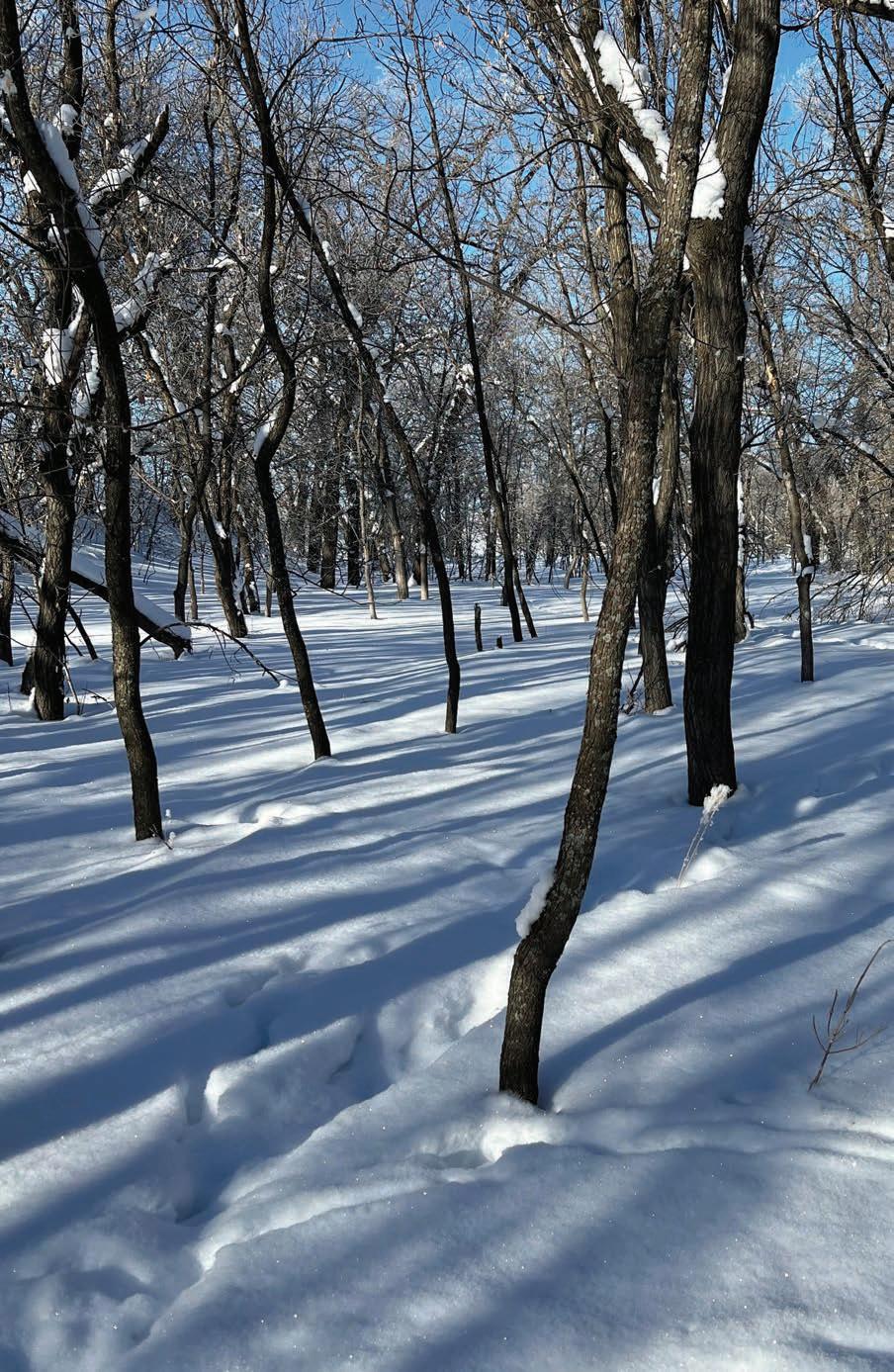
Even so, I had to get out of the house. I wanted to spot a fox squirrel sunning itself high up a cottonwood, it’s orangish coat giving up its whereabouts from 50 yards out. I wanted to lean against the rough bark of a burr oak tree, shoulder and aim my .22-caliber rifle with purpose and pull the trigger. I wanted to skin a squirrel or two, no matter how troublesome that so often is, with a new knife the kids got me for Christmas. I wanted to end it by slowly cooking a squirrel concoction that I’d likely be the only one eager to eat, which I’d be fine with.
What I got is what I expected. A painfully slow, knee-deep, and deeper slog through the woods that, if I didn’t know better from many successful hunts over the years, had never, ever held a squirrel and most likely never would.
I did see a bald eagle silently glide by as I was resting against a tree pondering my retreat from the woods. While cool, especially when you consider that such a sight was noteworthy when I started writing about the outdoors in North Dakota 30-plus years ago, it wasn’t what I’d come for.
The next day, leg-tired, a little less enthusiastic, but still wanting to drop something wild and fresh into the big slow cooker rather than dig out vacuum-sealed grouse, pheasants, gifted goose breasts or venison from the freezer, we pulled on long underwear and laced up winter boots for another day of it.
During the drive to another block of public land that boasted a cottontail population that was seemingly riding the high end of the cycle last winter, I envisioned us bumping rabbits, maybe even a couple reckless enough to linger within shooting range before ducking into thick cover.

I also pictured us laboring through snow deeper than we’d want or could negotiate to simply pull the trigger. My third-grade teacher, if she were riding shotgun, would have likely added: Didn’t you learn anything from yesterday?
Apparently not.
How I wanted the hunt to play out ended when the deer trail petered out and I sunk into snow up to my pants pockets. My son continued, not because he had something to prove, but simply because he could. He returned less than an hour later.
He bumped some rabbits he said but had to bust through waist-high snow to do it and never fired a shot. He did sneak up on a turkey sitting in a tree, he added, but like the eagle, it’s not what we’d come for.
ND OUTDOORS ■ FEBRUARY 2023 ■ 25
RON WILSON is editor of North Dakota OUTDOORS.
North Dakota Outdoors Magazine
North Dakota Game and Fish Department
100 N. Bismarck Expressway
Bismarck, ND 58501
To renew your subscription or change your address, call 701-328-6300 or go to gf.nd.gov/buy-apply.
Sometime in January from his office in Riverdale, Russ Kinzler, Missouri River System supervisor, uses a candle to slightly singe a walleye otolith, or ear bone, before placing it under a microscope to count the rings. Each ring on the otolith represents a year of growth, much like a tree’s rings indicate age. Over the years, Kinzler has aged countless walleye, sauger and rainbow smelt otoliths from fish netted in July from Lake Sakakawea for management purposes. The oldest walleye from Sakakawea, aged in 2018, was 27. This winter, three walleyes marked out at 21 years and were tabbed the oldest.
gf.nd.gov/connect

connect
us
with
ASHLEY PETERSON













 By Scott Winkelman
By Scott Winkelman

 SCOTT WINKELMAN is the Game and Fish Department’s chief warden.
ASHLEY PETERSON
SCOTT WINKELMAN is the Game and Fish Department’s chief warden.
ASHLEY PETERSON






 By Ron Wilson
By Ron Wilson









 RON WILSON is editor of North Dakota OUTDOORS.
RON WILSON is editor of North Dakota OUTDOORS.

 By Greg Power
By Greg Power












 SANDRA JOHNSON
ASHLEY PETERSON
ASHLEY PETERSON
SANDRA JOHNSON
ASHLEY PETERSON
ASHLEY PETERSON


















